Difference between revisions of "Template Only Features for Version 6.0 (OnePager Pro)"
(→Safely combine tasks from different files:) |
(→Task/Milestone Identity Mapping) |
||
| (41 intermediate revisions by the same user not shown) | |||
| Line 1: | Line 1: | ||
==About Template Only Features== | ==About Template Only Features== | ||
| − | 1) Because the '''Template Properties''' and Project-View Properties ('''PVP''') forms are similar, this article only covers the areas of the former that are different from the | + | 1) Because the '''Template Properties''' and Project-View Properties ('''PVP''') forms are similar, this article only covers the areas of the former that are different from the latter. |
| − | 2) You should familiarize yourself with the '''PVP''' form before reading this article. Please see the article at this link: [[Editing with the Project-View Properties form for Version 6.0 (Portal) | Editing with the Project-View Properties form (Portal)]] 21.0.1-60 for more information and access to more detailed articles. | + | 2) If you are unclear on the differences between a '''Template''' and a '''PVP''', please review the explanation in the [[Core Concepts for OnePager 6.0 (Portal) | Core Concepts (Portal)]] <!--4.0-60--> and [[Templates versus Project Views for Version 6.0 | Templates versus Project Views]] <!--4.3-60--> articles. |
| + | |||
| + | 3) You should familiarize yourself with the '''PVP''' form before reading this article. | ||
| + | |||
| + | 4) Please see the article at this link: [[Editing with the Project-View Properties form for Version 6.0 (Portal) | Editing with the Project-View Properties form (Portal)]] <!--21.0.1-60--> for more information and access to more detailed articles. | ||
==A Few Words On Templates== | ==A Few Words On Templates== | ||
| − | 1) '''Permanent Template''' Chronicle Graphics, Inc. ships '''OPP''' with one pre-defined permanent ''' | + | 1) '''Permanent Template'''. Chronicle Graphics, Inc. ships '''OPP''' with one pre-defined permanent '''Template''' that you cannot accidentally delete. |
| + | |||
| + | :a) The '''permanent Template''' has the word '''Permanent''' in its name. | ||
| + | |||
| + | :b) The '''permanent Template''' cannot be modified hence all the control features on each tab are disabled. | ||
| − | 2) '''Metric versus Non-Metric''' Within a '''Template''' there are settings which are measures that must be considered when building the project view | + | 2) '''Metric versus Non-Metric'''. Within a '''Template''' there are settings which are measures that must be considered when building the project view. |
:a) These include the '''height''' of individual rows, the '''height''' of the percent-complete bar within a task bar, and the like. | :a) These include the '''height''' of individual rows, the '''height''' of the percent-complete bar within a task bar, and the like. | ||
| − | :b) OnePager supports two measurement conventions: English ('''inches''') and Metric ('''centimeters'''). For convenience you can identify a '''Metric''' based '''Template''' because the word '''(metric)''' is included in the title. And these two sets of '''Templates''' are separated by default into English and a Metric | + | :b) OnePager supports two measurement conventions: (1) English ('''inches''') and (2) Metric ('''centimeters'''). For convenience, you can identify a '''Metric''' based '''Template''' because the word '''(metric)''' is included in the title. And these two sets of '''Templates''' are separated by default into English and a Metric sub-folder of the default '''Templates''' folder. |
3) In addition to the English and Metric folders in the '''Template''' folder there is a '''Legacy''' folder containing '''Templates''' from versions of '''OPP''' prior to version 5.3. | 3) In addition to the English and Metric folders in the '''Template''' folder there is a '''Legacy''' folder containing '''Templates''' from versions of '''OPP''' prior to version 5.3. | ||
| − | 4) Ideally, you will use one of the '''Templates''' provided | + | 4) Ideally, you will use one of the '''Templates''' provided one time and then from there you will customize your project views using your own customer '''Template'''. |
:a) Once a project view is customized it may be transformed into a '''Template''' using the '''Copy to Template''' button on the ribbon's '''Home''' tab. | :a) Once a project view is customized it may be transformed into a '''Template''' using the '''Copy to Template''' button on the ribbon's '''Home''' tab. | ||
| − | :b) | + | :b) Distributed '''Templates''' give you a starting point, but to maximize your efficiency, we recommend you learn how to create and update your own '''Templates'''. |
==Main Template Tab== | ==Main Template Tab== | ||
| − | 1) The '''Main''' tab of the '''Template Properties''' form differs slightly from the '''PVP''' form. The '''Template''' does not have entry | + | 1) The '''Main''' tab of the '''Template Properties''' form differs slightly from the '''PVP''' form. The '''Template''' does not have entry controls for the '''Start date''', '''End date''', '''Title''', because '''dates''' are systematically produced by OnePager based on the earliest '''start date''' and '''latest finish dates''' in your '''source plan''' data. The '''Title''' is something you designate as you create the new project view with the OnePager choices ('''OPC''') form. |
<center>[[File:P60-24_1_1-60-(1A)-02222017.png]]</center> | <center>[[File:P60-24_1_1-60-(1A)-02222017.png]]</center> | ||
| − | <center>P60-24_1_1-60-(1A)-02222017.png</center> | + | <!--<center>P60-24_1_1-60-(1A)-02222017.png</center>--> |
==Advanced Template Tab== | ==Advanced Template Tab== | ||
| Line 35: | Line 43: | ||
<center>[[File:P60-24_1_1-60-(2AA)-02222017.png]]</center> | <center>[[File:P60-24_1_1-60-(2AA)-02222017.png]]</center> | ||
| − | <center>P60-24_1_1-60-(2AA)-02222017.png</center> | + | <!--<center>P60-24_1_1-60-(2AA)-02222017.png</center>--> |
| − | :a) In the '''Template’s | + | :a) In the '''Template’s Advanced''' tab there is no '''Lock background''' checkbox in the '''Display options''' group. This is an option available after the project view is created. |
:b) One key difference between the '''Template Properties''' form and '''PVP''' form is the ability to use the '''Template''' to configure a '''multi-project''' import without the use of some sort of Microsoft Project Integrated Master Schedule ('''IMS'''). The next sub-section explains this further. | :b) One key difference between the '''Template Properties''' form and '''PVP''' form is the ability to use the '''Template''' to configure a '''multi-project''' import without the use of some sort of Microsoft Project Integrated Master Schedule ('''IMS'''). The next sub-section explains this further. | ||
| − | :c) For more information on creating multi-project project views please visit these two articles: | + | :c) For more information on creating '''multi-project''' project views please visit these two articles: |
| − | + | <center> | |
| + | {| class="wikitable" | ||
| + | | [[Basic Workflows for Version 6.0 (Portal) | Basic Workflows (Portal)]] <!--7.0.1-60--> | ||
| + | |- | ||
| + | | [[Creating Various Multi-Project Views with OnePager Pro and Express for Version 6.0 (Portal) | Creating Various Multi-Project Views with OnePager Pro and Express (Portal)]] <!--8.0.1-60--> | ||
| + | |} | ||
| + | </center> | ||
| − | + | ===Safely Combine Tasks From Different Files=== | |
| − | + | 3) Checking this checkbox puts any project views created with this '''Template''' into the '''multi-file multi-project mode'''. | |
| − | + | 4) This mode is specifically designed to support users who want to create '''multi-project''' project views from independent Microsoft Project '''source plans''' without creating a Microsoft Project '''IMS''' prior to creating the project view. | |
| − | + | 5) This is an advanced feature and when used, OnePager will number tasks and milestones imported from the various Microsoft Project '''source plans''' accessed differently than when only a '''single''' project '''source plan''' is imported. | |
| − | + | 6) This is done so that OnePager can support creation of subsequent '''snapshots''' for the '''multi-file multi-project''' project view in the future. | |
| + | |||
| + | 7) Once you adopted this scheme for the project view being created, it is not possible to update the project view in the future in the default '''single-file single-project mode.''' | ||
| + | |||
| + | 8) To enforce this requirement, the '''OPP'''’s '''PVP''' form’s '''Advanced''' tab shows the '''Safely combine tasks from different files''' checkbox but the command is disabled. | ||
<center>[[File:P60-24_1_1-60-(3A)-02222017.png]]</center> | <center>[[File:P60-24_1_1-60-(3A)-02222017.png]]</center> | ||
| − | <center>P60-24_1_1-60-(3A)-02222017.png</center> | + | <!--<center>P60-24_1_1-60-(3A)-02222017.png</center>--> |
==Field Mappings Template Tab== | ==Field Mappings Template Tab== | ||
| − | + | The new '''Field Mappings''' tab in the '''Template''' form for OnePager Pro looks like this: | |
| − | <center>[[File:P60-0_4_1_5-60-( | + | <center>[[File:P60-0_4_1_5-60-(7BB)-06052017.png]]</center> |
| − | <center>P60-0_4_1_5-60-( | + | <!--<center>P60-0_4_1_5-60-(7BB)-06052017.png</center>--> |
| − | + | ===Basic and Date Mappings=== | |
| − | + | 1) OnePager uses '''source fields''' for many purposes : displaying task names, displaying start dates, assigning colors to tasks, and grouping rows into swimlanes. We call the use of a '''source field''' for a purpose a '''field mapping'''. The eight dropdown lists above are a set of important '''field mappings''' that are collected in one form tab page. The other '''field mappings''' are on the Rows/Swimlanes, Task Bars, and Milestones form tab pages. Some '''field mappings''' (e.g. percent-complete) appear both here and on other form tab pages. | |
| − | + | 2) This new '''Field Mappings''' tab in the '''Template''' is also available in the '''PVP''' form. | |
| − | + | 3) Each dropdown list contains the '''source fields''' that have the correct data type(s) for the purpose. For example, in the '''Basic Mappings''' group, the '''Critical-path''' field dropdown contains only Boolean and numeric fields from Microsoft Project. And the dropdown lists in the '''Date Mappings''' group contain only Microsoft Project date fields. | |
| − | + | 4) These mappings are useful if your standard field usage differs and you want to avoid having to constantly make the changes on the second page of '''OPC''' form shown below: | |
<center>[[File:P60-3_0_1-60-(16AA)-03072017.png]]</center> | <center>[[File:P60-3_0_1-60-(16AA)-03072017.png]]</center> | ||
| − | <center>P60-3_0_1-60-(16AA)-03072017.png</center> | + | <!--<center>P60-3_0_1-60-(16AA)-03072017.png</center>--> |
| + | |||
| + | 5) For more detailed information on the use of this feature, please go to the article with starting section link: [[Field Mappings Tab for OnePager Pro for Version 6.0#Basic Mappings | Field Mappings Tab for OnePager Pro - Basic Mappings]] <!--21.15.1-60--> | ||
| + | |||
| + | ===Task/Milestone Identity Mapping=== | ||
| + | |||
| + | The '''Task/Milestone Identity Mapping''' group lets you select a Microsoft Project field that can be used to uniquely identifies each task. | ||
| + | |||
| + | 1) Uniquely identifying each task or milestone is always important when you plan to update your project view later on, but you normally do not need to change this '''field mapping''' because the default mapping works just fine. | ||
| + | |||
| + | :a) OnePager uses the '''Unique Id''' field to identify each task in the '''source plan''', enabling preservation of each task’s color, labeling, and vertical location as you import new or modified data in later updates of the project view. | ||
| + | |||
| + | :b) For '''source plans''' that are Microsoft Project .MPP files, the default mapping is to the Microsoft Project '''Unique ID''' field. When the '''source plan''' resides on Microsoft Project Server or Microsoft Project Online and you import directly from the server, the default mapping change automatically to the Microsoft Project '''GUID''' field. | ||
| + | |||
| + | :c) If you opt to change the '''Unique Id''' mapping away from these reliable defaults, make sure that the new '''source''' field has a unique value for each task or milestone. Bear in mind that once you create a project view with a '''Unique Id''' mapping, it is nearly impossible to change your mind about how tasks are to be identified. Change this mapping away from the default only if you have a good reason to do so and are sure that the field contains no duplicate values. | ||
| + | |||
| + | 2) To map an alternate '''Unique Id''' field, use the dropdown menu shown in the illustration below: | ||
| + | |||
| + | <center>[[File:P60-24_1_1-60-(8AA)-06052017.png]]</center> | ||
| + | <!--<center>P60-24_1_1-60-(8AA)-06052017.png</center>--> | ||
| + | |||
| + | 3) When changing to an alternate '''Unique Id''' field, OnePager will display a warning message as follows: | ||
| + | |||
| + | <center>[[File:P60-24_1_1-60-(9AA)-06052017.png]]</center> | ||
| + | <!--<center>P60-24_1_1-60-(9AA)-06052017.png</center>--> | ||
| + | |||
| + | 4) For more information on this feature, please go to this link: [[Field Mappings Tab for OnePager Pro for Version 6.0#Task/Milestone Identity Mapping | Field Mappings Tab for OnePager Pro - Task/Milestone Identity Mapping]] <!--21.15.1-60--> | ||
| + | |||
| + | ===Field Splitting=== | ||
| + | |||
| + | 4) The '''Field Splitting''' group lets you split each task into a set of nearly-duplicate tasks based upon a comma-separated list of values in some '''source''' field. For example, you could split a task that had three '''Resource Names''' assigned to it into three almost-identical tasks that differ only in their value of '''Resource Name'''. Once you create a project view with '''field splitting''' turned on, it is impossible to change your mind and go back to '''unsplit''' tasks for that project view or change to a different field for the splitting. | ||
| − | + | 5) See the article at: [[Splitting and Parsing Columns for OnePager Pro for Version 6.0 | Splitting and Parsing Columns-OnePager Pro]] <!--24.4.1-60--> for more information. | |
| − | + | 6) For more information on the '''Field Mappings''' Tab, see the article at this link: [[Field Mappings Tab for OnePager Pro for Version 6.0 | Field Mappings Tab for OnePager Pro]] <!--21.15.1-60-->. | |
(24.1.1-60) | (24.1.1-60) | ||
| Line 95: | Line 143: | ||
[[Category:Snapshots]] | [[Category:Snapshots]] | ||
[[Category:Templates]] | [[Category:Templates]] | ||
| + | [[Category:Unique ID]] | ||
[[Category:Templates Versus Project Views]] | [[Category:Templates Versus Project Views]] | ||
[[Category:Project-View Properties Form]] | [[Category:Project-View Properties Form]] | ||
[[Category:OnePager Pro]] | [[Category:OnePager Pro]] | ||
Latest revision as of 16:47, 5 June 2017
Contents
About Template Only Features
1) Because the Template Properties and Project-View Properties (PVP) forms are similar, this article only covers the areas of the former that are different from the latter.
2) If you are unclear on the differences between a Template and a PVP, please review the explanation in the Core Concepts (Portal) and Templates versus Project Views articles.
3) You should familiarize yourself with the PVP form before reading this article.
4) Please see the article at this link: Editing with the Project-View Properties form (Portal) for more information and access to more detailed articles.
A Few Words On Templates
1) Permanent Template. Chronicle Graphics, Inc. ships OPP with one pre-defined permanent Template that you cannot accidentally delete.
- a) The permanent Template has the word Permanent in its name.
- b) The permanent Template cannot be modified hence all the control features on each tab are disabled.
2) Metric versus Non-Metric. Within a Template there are settings which are measures that must be considered when building the project view.
- a) These include the height of individual rows, the height of the percent-complete bar within a task bar, and the like.
- b) OnePager supports two measurement conventions: (1) English (inches) and (2) Metric (centimeters). For convenience, you can identify a Metric based Template because the word (metric) is included in the title. And these two sets of Templates are separated by default into English and a Metric sub-folder of the default Templates folder.
3) In addition to the English and Metric folders in the Template folder there is a Legacy folder containing Templates from versions of OPP prior to version 5.3.
4) Ideally, you will use one of the Templates provided one time and then from there you will customize your project views using your own customer Template.
- a) Once a project view is customized it may be transformed into a Template using the Copy to Template button on the ribbon's Home tab.
- b) Distributed Templates give you a starting point, but to maximize your efficiency, we recommend you learn how to create and update your own Templates.
Main Template Tab
1) The Main tab of the Template Properties form differs slightly from the PVP form. The Template does not have entry controls for the Start date, End date, Title, because dates are systematically produced by OnePager based on the earliest start date and latest finish dates in your source plan data. The Title is something you designate as you create the new project view with the OnePager choices (OPC) form.
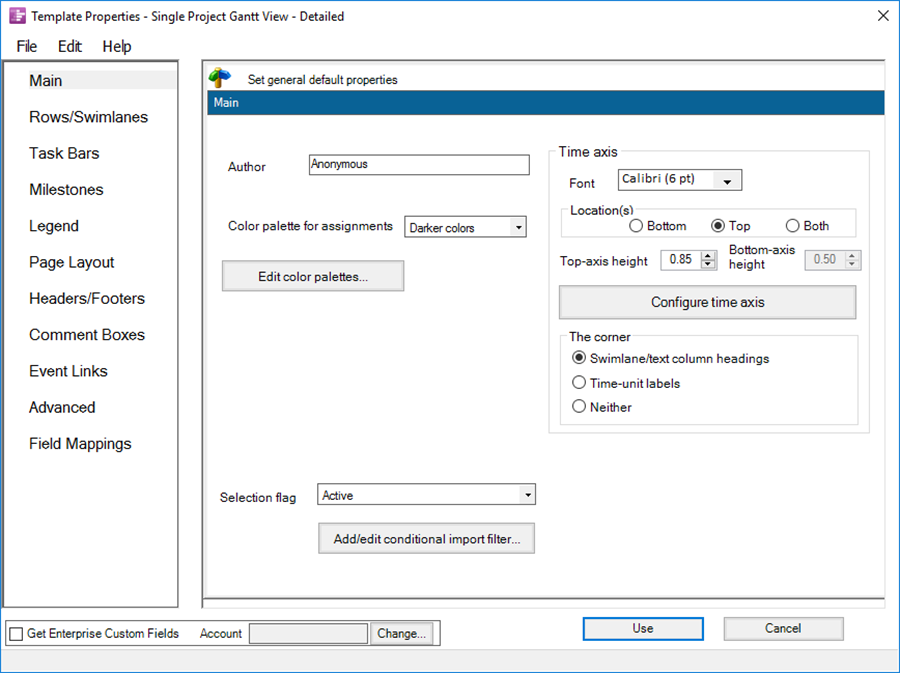
Advanced Template Tab
2) The Advanced tab is shown below. Most of these parameters in the Template are identical to those appearing in the PVP form.
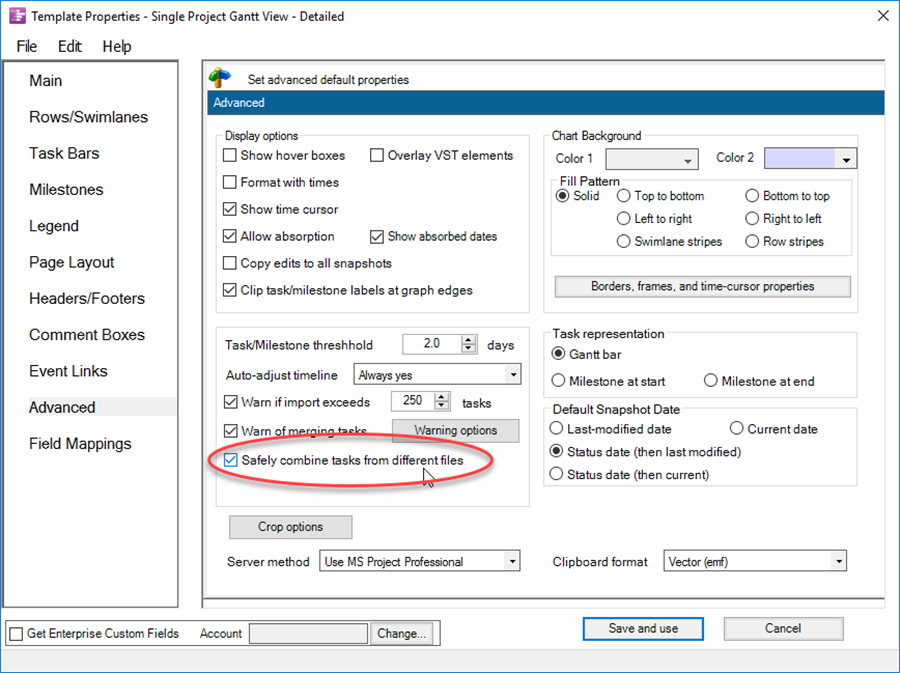
- a) In the Template’s Advanced tab there is no Lock background checkbox in the Display options group. This is an option available after the project view is created.
- b) One key difference between the Template Properties form and PVP form is the ability to use the Template to configure a multi-project import without the use of some sort of Microsoft Project Integrated Master Schedule (IMS). The next sub-section explains this further.
- c) For more information on creating multi-project project views please visit these two articles:
| Basic Workflows (Portal) |
| Creating Various Multi-Project Views with OnePager Pro and Express (Portal) |
Safely Combine Tasks From Different Files
3) Checking this checkbox puts any project views created with this Template into the multi-file multi-project mode.
4) This mode is specifically designed to support users who want to create multi-project project views from independent Microsoft Project source plans without creating a Microsoft Project IMS prior to creating the project view.
5) This is an advanced feature and when used, OnePager will number tasks and milestones imported from the various Microsoft Project source plans accessed differently than when only a single project source plan is imported.
6) This is done so that OnePager can support creation of subsequent snapshots for the multi-file multi-project project view in the future.
7) Once you adopted this scheme for the project view being created, it is not possible to update the project view in the future in the default single-file single-project mode.
8) To enforce this requirement, the OPP’s PVP form’s Advanced tab shows the Safely combine tasks from different files checkbox but the command is disabled.
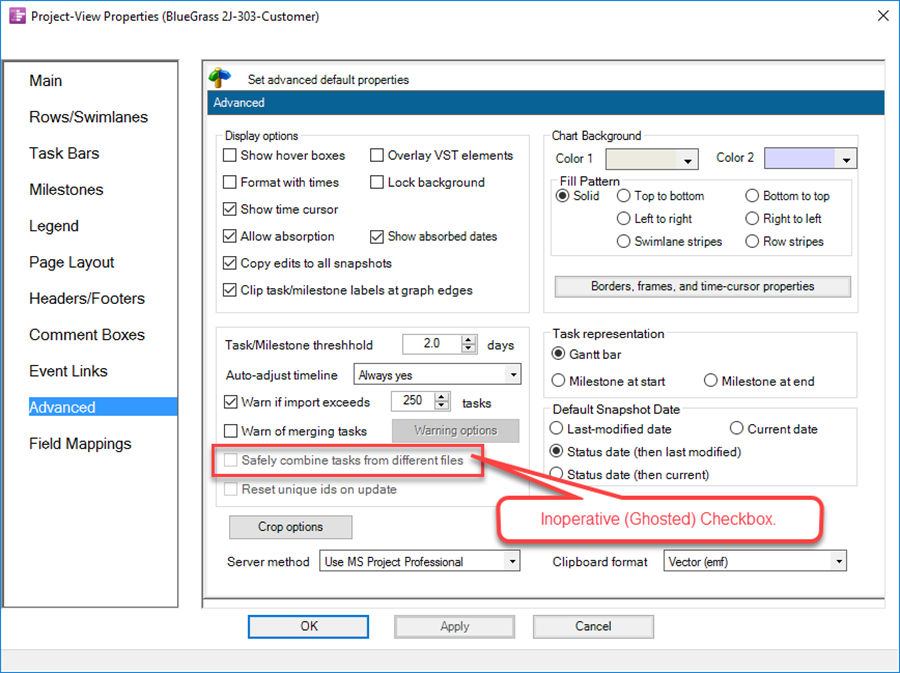
Field Mappings Template Tab
The new Field Mappings tab in the Template form for OnePager Pro looks like this:
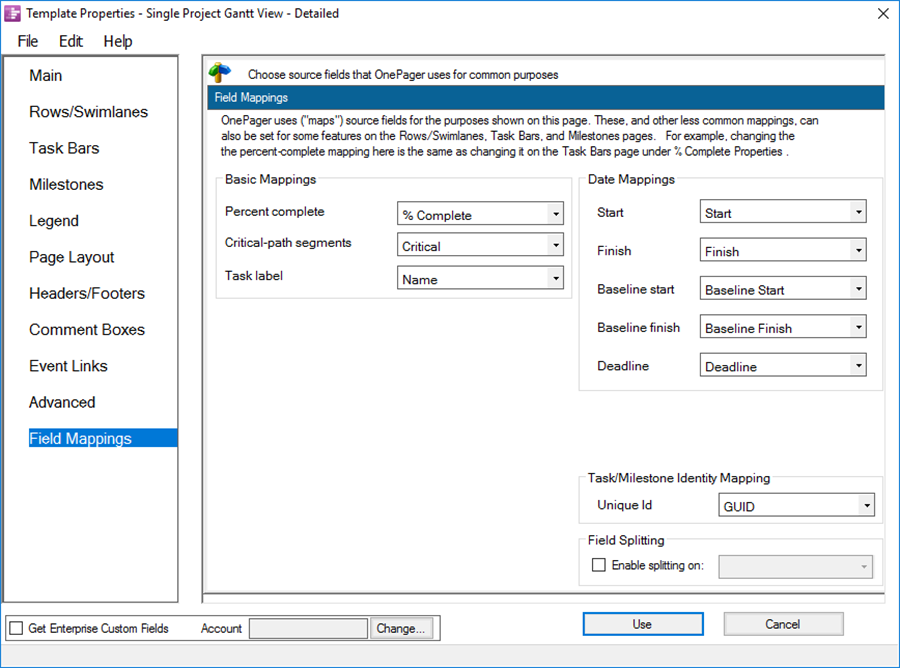
Basic and Date Mappings
1) OnePager uses source fields for many purposes : displaying task names, displaying start dates, assigning colors to tasks, and grouping rows into swimlanes. We call the use of a source field for a purpose a field mapping. The eight dropdown lists above are a set of important field mappings that are collected in one form tab page. The other field mappings are on the Rows/Swimlanes, Task Bars, and Milestones form tab pages. Some field mappings (e.g. percent-complete) appear both here and on other form tab pages.
2) This new Field Mappings tab in the Template is also available in the PVP form.
3) Each dropdown list contains the source fields that have the correct data type(s) for the purpose. For example, in the Basic Mappings group, the Critical-path field dropdown contains only Boolean and numeric fields from Microsoft Project. And the dropdown lists in the Date Mappings group contain only Microsoft Project date fields.
4) These mappings are useful if your standard field usage differs and you want to avoid having to constantly make the changes on the second page of OPC form shown below:
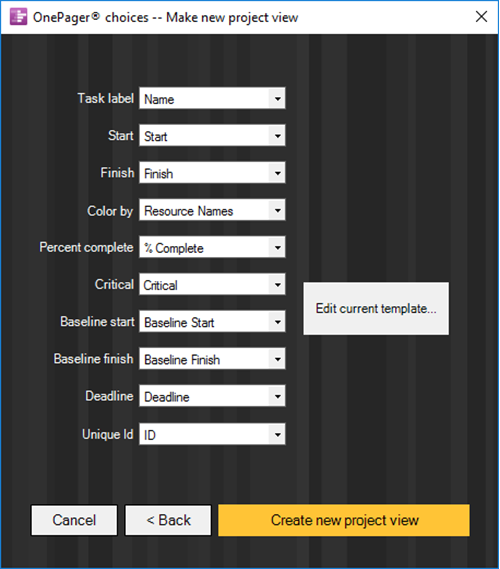
5) For more detailed information on the use of this feature, please go to the article with starting section link: Field Mappings Tab for OnePager Pro - Basic Mappings
Task/Milestone Identity Mapping
The Task/Milestone Identity Mapping group lets you select a Microsoft Project field that can be used to uniquely identifies each task.
1) Uniquely identifying each task or milestone is always important when you plan to update your project view later on, but you normally do not need to change this field mapping because the default mapping works just fine.
- a) OnePager uses the Unique Id field to identify each task in the source plan, enabling preservation of each task’s color, labeling, and vertical location as you import new or modified data in later updates of the project view.
- b) For source plans that are Microsoft Project .MPP files, the default mapping is to the Microsoft Project Unique ID field. When the source plan resides on Microsoft Project Server or Microsoft Project Online and you import directly from the server, the default mapping change automatically to the Microsoft Project GUID field.
- c) If you opt to change the Unique Id mapping away from these reliable defaults, make sure that the new source field has a unique value for each task or milestone. Bear in mind that once you create a project view with a Unique Id mapping, it is nearly impossible to change your mind about how tasks are to be identified. Change this mapping away from the default only if you have a good reason to do so and are sure that the field contains no duplicate values.
2) To map an alternate Unique Id field, use the dropdown menu shown in the illustration below:
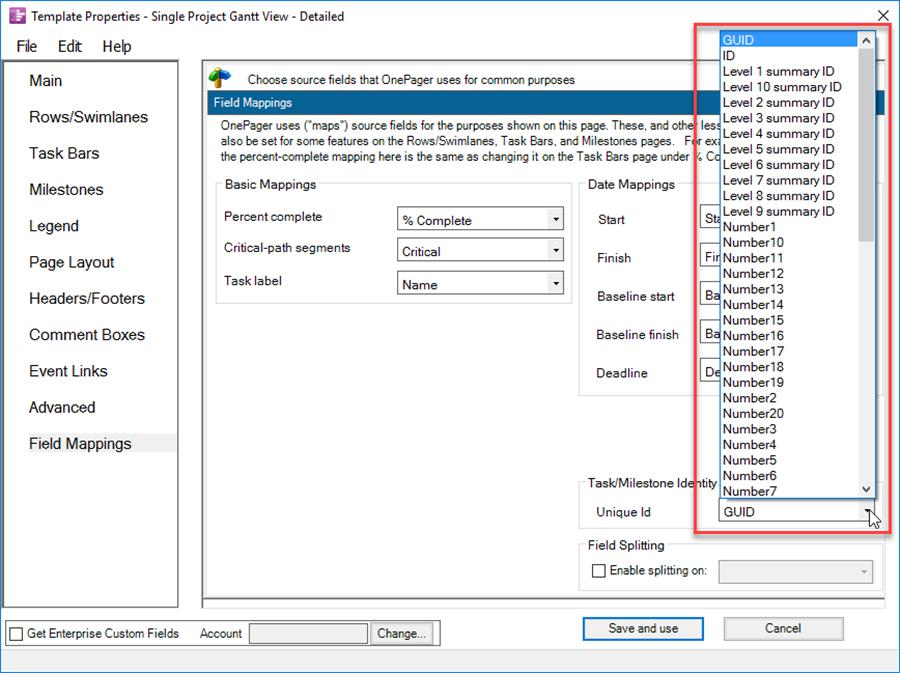
3) When changing to an alternate Unique Id field, OnePager will display a warning message as follows:
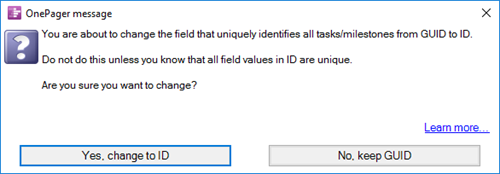
4) For more information on this feature, please go to this link: Field Mappings Tab for OnePager Pro - Task/Milestone Identity Mapping
Field Splitting
4) The Field Splitting group lets you split each task into a set of nearly-duplicate tasks based upon a comma-separated list of values in some source field. For example, you could split a task that had three Resource Names assigned to it into three almost-identical tasks that differ only in their value of Resource Name. Once you create a project view with field splitting turned on, it is impossible to change your mind and go back to unsplit tasks for that project view or change to a different field for the splitting.
5) See the article at: Splitting and Parsing Columns-OnePager Pro for more information.
6) For more information on the Field Mappings Tab, see the article at this link: Field Mappings Tab for OnePager Pro .
(24.1.1-60)